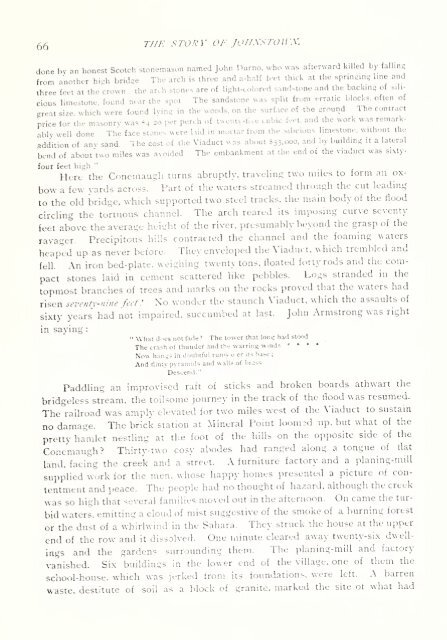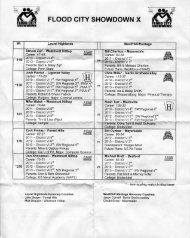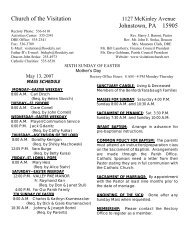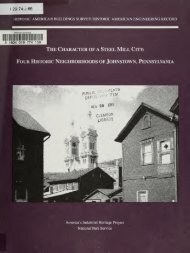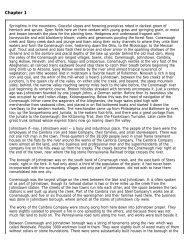- Page 2 and 3:
Gc 974,802 J65mac 1676688 M-C REYNO
- Page 4 and 5:
Digitized by the Internet Archive i
- Page 6 and 7:
The Story of Johnstown ITS EARLY SE
- Page 9 and 10: Oipyrij;lued, JAMES .M. ('LACE, \V
- Page 11 and 12: PUBLISHER'S PREFACE. Any commercial
- Page 13 and 14: — c ONTENTS. I. HOMES IN THE WILD
- Page 15 and 16: — — — co.yr/-:.\rs. culiar Ex
- Page 17 and 18: THE STORY OF JOHXSTOWX. Brother—
- Page 19 and 20: 24 THE STORY OF JOJ/XSTOUW. Jirowl
- Page 21 and 22: ' 26 THE STORY OF JOHXSTOlVy. "Colo
- Page 23 and 24: There 28 THE STORY OF JonxSTOUW'. d
- Page 25 and 26: EARLY SETTLEMENT. Genekai, Campbell
- Page 27 and 28: 32 THE STORY (^F JOHX-sTOWX. lawful
- Page 29 and 30: 34 THE STORY OF JOHXSroWX. with suc
- Page 31 and 32: 36 T/n: s TONY t '/• jo/fxs > w.x
- Page 33 and 34: John gives John Samuel 38 Tin: STOR
- Page 35 and 36: 40 THE STORY or JO//\S'TOll-\. bulk
- Page 37 and 38: to 42 THE STORY OF jo//.xsr
- Page 39 and 40: ' :' •' , ;-. " : ward J retained
- Page 41 and 42: 46 /HE < 1 OK y uF joii.\ s low x.
- Page 43 and 44: . V. THE SOUTH-FORK DAM. How AN Art
- Page 45 and 46: Howard W. Secretary, C, THE SOCTIl-
- Page 47 and 48: TI/i: SOlTfl-l-OKK IKIM 30 the ,l;
- Page 49 and 50: THE SOLTI/.FOKK IKIM. -- minmes suf
- Page 51 and 52: with Tin: S0UTH-1\>RK IKIM. -- 5/ t
- Page 53 and 54: 4. .": ^i 1 * ^•-"\ -V- ^: :^s; V
- Page 55 and 56: 62 T/IE Sl'ORY OF JOaXSTOWX. them a
- Page 57: 64 ////; STOA')' cr /o//.vs/ the Co
- Page 61 and 62: The 68 rf!i: s roRV ( '/ /< '//.\ >
- Page 63 and 64: 70 THE STORY OF JOHXSroWX. awav wit
- Page 65 and 66: Yll. WRECK OF THE DAY EXPRESS. A Th
- Page 67 and 68: WRECK or Tin: y;.,!' express. -- fr
- Page 69 and 70: The lump, The irKKCK (>J' THE DAY E
- Page 71 and 72: Drenched thus, ' JTRECA' OF TffK DA
- Page 73 and 74: irjf£cA' OF T//K DAY EXPRESS. Si s
- Page 75 and 76: VIII \VOOlJ\ALE ANXnilLATED. A Pret
- Page 77 and 78: U-00/U:iLE ,]y.\lHlL.\TKD. 85 Sup-^
- Page 79 and 80: I! VOD I -ALE . IWiniLA TED. '^7 ta
- Page 81 and 82: ]VOOD]:iLK AXSIHIl.ATED. 89 purchas
- Page 83 and 84: ,', between ', and 90 J' OF fi)//.\
- Page 85 and 86: 9^ THE STORY OF JOUXSTOWX. naked ro
- Page 87 and 88: -• •^^* ; ' I IX THREE THOUSAND
- Page 89 and 90: . THREE Tiro USA .\1> PERSOXS PEK/S
- Page 91 and 92: ,-• THREE THOrSAXD PERSOXS PERISH
- Page 93 and 94: TiiKEi: THorsAxn /•/:a\\,>xs rija
- Page 95 and 96: THREE THOVSAXD EERSOXS EERIS!/. 103
- Page 97 and 98: ^•' 3" r / C' 6
- Page 99 and 100: Now loS THE sroKY OF joii.xsroww. f
- Page 101 and 102: , . 1 no THE STORY OF JOl/XSTOWX. d
- Page 103 and 104: J J, THE STORY OF JOIIXSTOWX. stick
- Page 105 and 106: llail I[. THE STORY OF JOHXSTOWX. c
- Page 107 and 108: Il6 THE STOKY OF JOfLXSTOW'X. by, t
- Page 109 and 110:
'. ii8 THE STORY OF JOIISSTOIVS. wa
- Page 111 and 112:
I20 THE S n 'A' ] ' ( '/-^ /I '/A\>
- Page 113 and 114:
I 2 2 77//:' .•- n Vv' 1 ' ( '/
- Page 115 and 116:
124 77//.' .v/V'AM' (U-- JCZ/XSTOir
- Page 117 and 118:
126 THE STORY OF Ji U/.\S7\>ll X. i
- Page 119 and 120:
Fifty 128 Tin: STORY or joirxsTowx.
- Page 121 and 122:
It Thousands Death CIJMJ'.^KS OF TH
- Page 124 and 125:
XII. FATE OF PASTDlvS AND CHURCHES.
- Page 126 and 127:
mit It FATE OF PASTORS AX1> l7/FA'C
- Page 128 and 129:
FATE OF PASTORS A.\D CHURCIfES. fmi
- Page 130 and 131:
FATE OF r.lSTOKS AXF C//C'KC//FS. I
- Page 132:
' St. FATE or PASTORS A.\D ClIURCHE
- Page 135 and 136:
'. ' ' -' ,' 7'r .. FATE OF PASTORS
- Page 137 and 138:
.-lTE Cr P.ISTOKS A.Xl) C/irKCHE. 1
- Page 140 and 141:
X!I!. ADVENTURES AND ESCAPES. Xo Sc
- Page 142 and 143:
.IDrEXTC'KIiS AXD ESCAPES. I -I con
- Page 144 and 145:
Conrad Fr.ank ADVEXJ-rRKS AX/) JCSC
- Page 146 and 147:
.•/ /> / 7:.\TC 7v'/;.s . /.\7^ K
- Page 148 and 149:
.-!D\-EXT['R/:S .l.V/> KSC.U'KS. 0/
- Page 150 and 151:
.U>i7-:\Tf'A'/:S A.XD i-:sc.iPKs. 1
- Page 152 and 153:
I've A!>i7:xTr-K/:s .ix/> ksc.ip/cs
- Page 154 and 155:
Ai>VE.\TrK/:s .i.y/> i:sc\i/'/-:s.
- Page 156 and 157:
AD I T.yn 7t debris that had collec
- Page 158 and 159:
ADl'KXrrKKS ,lX/> KSlAPES. 1 67 Tlu
- Page 160 and 161:
1^ l^.'\ \ V ;*^l '»• * U-^f r /
- Page 162 and 163:
' " I - 2 THE STOR ) ( '/•" /( UI
- Page 164 and 165:
174 'i'^t-' i^TORY or JOllXSTOUW. a
- Page 166 and 167:
1/6 Th'E STORY OF JOILXSTOU'X. roof
- Page 168 and 169:
I7,S THE sroRY oi' jo/ixsrow x. sta
- Page 170 and 171:
private afterward ]8o Tin: STORY or
- Page 172 and 173:
Tile I S 2 THE STOR ) OF JOZ/XSTOUW
- Page 174 and 175:
iS4 '^'^ff'' STORY nj- joj/\sro\fX.
- Page 176 and 177:
1 86 THE rroR 1 he oo " and ( '/•
- Page 178 and 179:
. Faces I XY. DISPOSAL (^F THE DEAD
- Page 180 and 181:
lUSPOS.SL or THE DEAD. 191 the ('li
- Page 182 and 183:
send n/SPOS.lL OF 77/E 7)1:AD. •9
- Page 184 and 185:
n/SPOS.lI. ,!/• THE DEAD. 195 a p
- Page 186 and 187:
""""""^^^^^ : f>/SPOS,!L or THE DEA
- Page 188 and 189:
' .\11 gone ! can " n/SPOS.!/-. OF
- Page 190 and 191:
John hero D/SPOS.IL Of THE DEAlK 20
- Page 192 and 193:
lack onl\- the thunder f>/srnsA/. o
- Page 194 and 195:
DJSP(1S.!I. OF TflK PK.in. 205 'I'h
- Page 196 and 197:
A Surel\- DISPOSAL OJ- THE VKAD. 20
- Page 199 and 200:
that and and n/SP()S.l/. OF THE Dll
- Page 201 and 202:
MEKCHAMh. AMJ u
- Page 203 and 204:
2 14 THE STORY OF JOJrXSTOWX. lovft
- Page 205 and 206:
Miss a ' Fitzharris. Mrs. Dr. John
- Page 207 and 208:
2l8 THE sTiiRY (U- jnii'xsrowx. in
- Page 209 and 210:
his Robert, his Mrs. 220 TffE STORY
- Page 211 and 212:
22 2 7'///; SVOA']' (U-' fO/LXSTOir
- Page 213 and 214:
TJ/F. ' 224 ' sro/xY OF yoj/.\sj\ur
- Page 215 and 216:
Broad number .Mrs Th^^mas Chestnut
- Page 217:
that's or 22S THE STOK)' i>F JOJ/XS
- Page 220 and 221:
The\- 232 THE STORY OF JOILXSTOWX.
- Page 222 and 223:
' Mother, I ' 2:,4 THE sroRV or jo>
- Page 224 and 225:
10 s/.Aro///7:A- or rin: i.wocexts.
- Page 226 and 227:
My she si.Ai\;/rrER >
- Page 228 and 229:
SL.irGJ/TKR OF THE LWOCEXTS. 239 \
- Page 230 and 231:
Their I Would but, SL.-U'Crf/TER OF
- Page 232 and 233:
sLAru/i"j'i:R ('/ '////: jxxocKXTs.
- Page 234 and 235:
So All SLACGHTER OF 'J HE /XXOCEXTS
- Page 236 and 237:
M 1 f T^-^ , .,, Vt^mSfSX:^ '^il:^^
- Page 238 and 239:
250 TlIF liii- STORY OF JOHSSrOWS.
- Page 240 and 241:
' Here's an order tor fifty tiarrel
- Page 242 and 243:
Sturdv Men 254 T^'^- •'^/'-'A'l'
- Page 244 and 245:
256 THE STORY OF JOHXSTOWX. suppose
- Page 246 and 247:
She 258 THE STORY OF JOf/.XSTOWX. A
- Page 248 and 249:
XIX. ORDER OUT OF CHAOS. Thk Lawles
- Page 250 and 251:
OK !'/:,'< Ol'T OF C/r.lOS. 26:; ex
- Page 252 and 253:
which ORDKR OCT OF Cff.lOS. J65 tio
- Page 254 and 255:
' .\nd that How ' OKDF.K Orr i>r i7
- Page 256 and 257:
Main OKPER OCT OF CN.iOS. 26c (II f
- Page 258 and 259:
^iy^^L. '--7 -ifeTiiv /y^^vm' "^ ^
- Page 260 and 261:
J74 'f'fl^'- >/"A'!' OF J(y/.\STOU:
- Page 262 and 263:
so 276 THE STORY OF fnllXSTOWX. tha
- Page 264 and 265:
for 27S THE sroR)- OF jo/fxsrojrx.
- Page 266 and 267:
2So T/fE STORY OF JO//.\STOU:\'. an
- Page 268 and 269:
Lieutenant-Colonel Lieutenant Lieut
- Page 270 and 271:
r.w'AVv' Mii.nwm' .irraoRrr): 2S3 ^
- Page 272 and 273:
It ; -.\7'/i7v' J///./7: / A' J .n
- Page 274 and 275:
ut rX/iF.R MILITARY .ir'n/OR/TY. 28
- Page 276 and 277:
Lieutenants. Second The rxr>KK MriJ
- Page 278 and 279:
The Ju'y L'X/>/-:/^ MILITARY ArT/rO
- Page 280 and 281:
.\7>/;A' MILITARY Al'TIlORITV. 293
- Page 282 and 283:
in LWDKK MILUWRV A rTIlORITY. 2t,S
- Page 284 and 285:
V 'rrr-r^ — - '''-•\WRS, ..«.-
- Page 286 and 287:
300 THi: sronv of joi!.\sro\\-.\. a
- Page 288 and 289:
For 2t,3S9 302 77//: sro/^)- oj' /o
- Page 290 and 291:
At the fnun and the 304 T/fK STORY
- Page 292 and 293:
S15 ministers, there 3o6 T/n: .s'/v
- Page 294 and 295:
3o8 THE X/VVv'l' OF Joif.\srO\\-.\.
- Page 296 and 297:
3IO THE .sTr '/.') I'l- JO/fXSrOWX.
- Page 298 and 299:
• 3 2 Tin: sr( '.V 1 ( '/ /( ufxs
- Page 300 and 301:
We 314 Tf/E STORY I'F JOHXSTOUW. qu
- Page 302 and 303:
XXIl. FLOOD RELIEF COMMISSION. PkoM
- Page 304 and 305:
Modesth' Jl.OOn REIJhl' COMMISSIOX.
- Page 306 and 307:
t'Sliiuates of losses, the claimant
- Page 308 and 309:
Fl.OOn RKLlliF COMynssiOX. 1,11 IiK
- Page 310 and 311:
FLiHW REIJEr COMMISSUW. 325 lit Si.
- Page 312 and 313:
The FLOOD RELIEF C0.1LULk
- Page 314 and 315:
7.oor> ri:lii:f commissiox. 3^9 for
- Page 316 and 317:
XAIll kxpi-:rikxci:s and obser\'ati
- Page 318 and 319:
ut but E.xPKh'/r.xcEs .-Lv/i ( >/;.
- Page 320 and 321:
I'or KXPKRfi:xcj:s . i.\/> ( '/•s
- Page 322 and 323:
£.\T£A'/£XC£S .-/.\7) O/ISK/C r
- Page 324 and 325:
.' y
- Page 326 and 327:
' 342 THE STORY OF /('//.YSTOUW. li
- Page 328 and 329:
344 77//; .V7V)AM^ Of- /il//XS7VirX
- Page 330 and 331:
nine • 346 THE STORY OF /0//XSTiU
- Page 332 and 333:
initials—that although mv 348 THE
- Page 334 and 335:
350 THE STORY OF JOUXSTOWX. flood W
- Page 336 and 337:
June 352 THE STORY OF JOHXSTOWX. A
- Page 338 and 339:
He and 354 '^J^^'^ STOR 1 ' ( '/•
- Page 340 and 341:
XXVI, LIGHTS AND SHADOWS. Hosts of
- Page 342 and 343:
LIGHTS AM) S/r.-lDOWS 357 nianded e
- Page 344 and 345:
Slick Liiitrrs Axn sifAPows. 359 ha
- Page 346 and 347:
' Run A Run LIGHTS A.\D SIL\lH>]rs.
- Page 348 and 349:
Ts^r^.c'r-rri -t^-. "-.^f ;rvn *•
- Page 350 and 351:
366 THE STi^RY OF jn/fXSTOirX. peri
- Page 352 and 353:
v"-s THE STORY OF JOl/XSTtnWX. supp
- Page 354 and 355:
370 TifE sTtiRV OF jonxsrowx. talc
- Page 356 and 357:
3/^ -V 374 THE STORY or jonxsrow.w
- Page 358 and 359:
376 :T,)/n' or /(i//.\\ Jo.iv.-.. M
- Page 360 and 361:
Mrs. . 378 THE S Ti IRV ( '/• JO/
- Page 362 and 363:
380 THE STORY Ol' jnjfXST(i\':\. Yo


